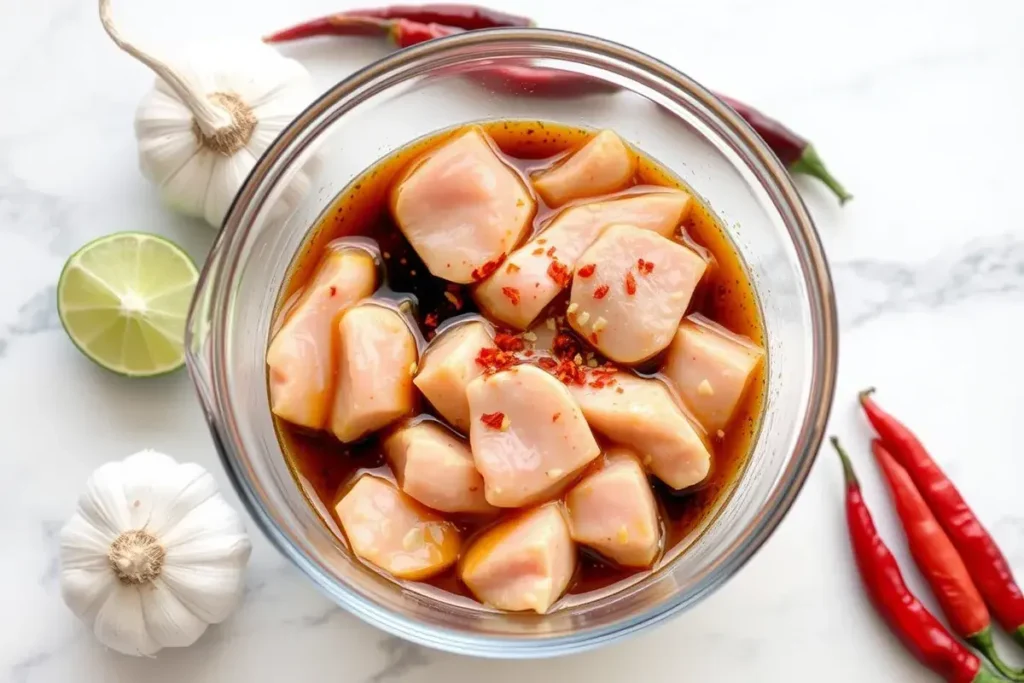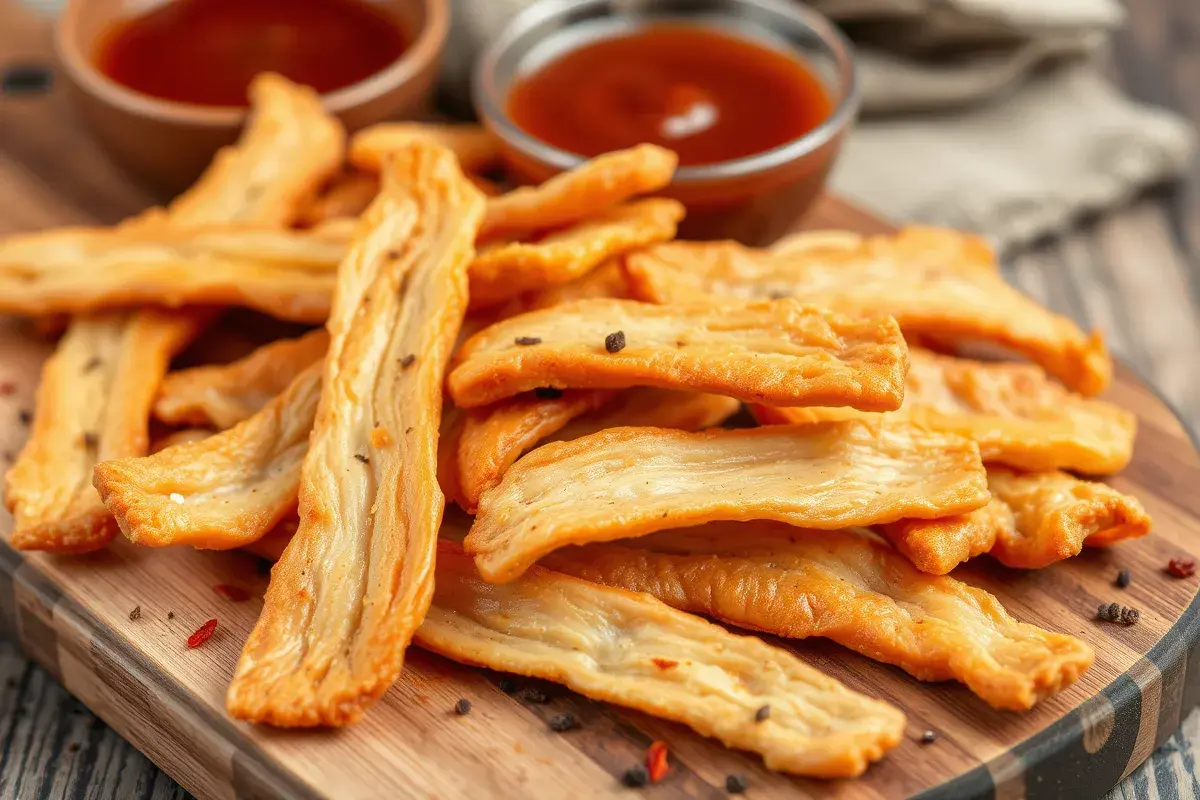1. Why Choose Chicken Jerky Over Other Jerky Types?
People often wonder why one should pick chicken jerky instead of beef, turkey, or other common options. The answer lies in several benefits:
- Lower Fat Content: Chicken, especially the breast, remains lean. Therefore, chicken jerky provides a protein-rich snack with fewer calories than beef jerky.
- Milder Flavor: The flavor of chicken is mild, making it easier to pair with various spices and marinades.
- Versatile Texture: Proper dehydration leads to a tender, chewy texture that many find easy to enjoy.
- Accessible and Affordable: Chicken is often more affordable and readily available than other meats, making it a practical choice.
Moreover, chicken jerky adapts well to numerous flavors. For instance, you can add a sweet and spicy glaze or create a savory, herb-infused marinade. In addition, it appeals to those looking for lighter snacks that still keep them feeling full and satisfied.
2. Understanding The Basics Of Chicken Jerky
Before starting your first batch, it is important to understand the basics. Chicken jerky results from drying thin strips of chicken at low temperatures until most moisture evaporates. This drying method prevents bacterial growth and extends the shelf life. However, some steps are necessary to avoid food safety issues.
2.1 Key Points
- Use fresh, high-quality chicken.
- Trim all visible fat. This step helps improve shelf life.
- Season and marinate for flavor.
- Dry the chicken at the correct temperature.
- Store in airtight containers to maintain freshness.
2.2 Important Considerations
- Temperature Control: Chicken must reach a safe internal temperature (generally 165°F or 74°C) before dehydration. Therefore, you may consider preheating or briefly baking the strips to that safe temperature.
- Uniform Slices: Cutting your chicken into uniform strips helps them dry evenly. Moreover, this results in a more consistent final texture.
- Short Marinating Times: Chicken often takes on flavors quickly. In addition, a few hours may be enough for a flavorful jerky.
3. Selecting The Right Cut For Chicken Jerky
Choosing the right cut sets the foundation for good chicken jerky. Most people prefer chicken breast due to its low fat and mild flavor. However, chicken thighs work well if you prefer a richer taste.
3.1 Best Cuts
- Chicken Breast:
- Lean and uniform.
- Mild taste that pairs well with various marinades.
- Less trimming required.
- Boneless, Skinless Chicken Thighs:
- Slightly richer flavor.
- More fat means a less dry texture, but shorter shelf life.
- Might need more trimming.
In addition, always start with fresh chicken. Frozen chicken works if thawed properly before slicing. However, fresh chicken yields a cleaner flavor. Moreover, check the quality and smell before starting, as freshness directly affects the final taste.
4. Preparing The Meat For Chicken Jerky
Proper preparation is essential for a safe and tasty product. In addition, careful prep reduces the risk of bacterial growth.
4.1 Steps To Prepare
- Trim Fat and Connective Tissue:
Remove any visible fat, sinew, or gristle. This step prevents rancidity and ensures a clean bite. - Slice Evenly:
Cut the chicken into thin, uniform strips. Aim for strips about 1/4-inch thick. Thicker pieces take longer to dry, while thinner pieces may become too brittle. - Partially Freezing For Easier Slicing:
For more uniform slices, consider placing the chicken in the freezer until slightly firm, about 30 minutes. This tip makes slicing smoother, resulting in better consistency.
Moreover, always keep raw chicken separate from other ingredients to avoid cross-contamination. Therefore, sanitize your knives, cutting boards, and utensils after handling raw meat.
5. Marinating And Seasoning Your Chicken Jerky

Flavoring your chicken jerky can transform it from plain to crave-worthy. In addition, marinades help tenderize the strips, imparting depth to every bite.
5.1 Basic Marinade Components
- Salt and Soy Sauce: A salty base that helps preserve and flavor.
- Acidic Ingredient (e.g., Vinegar or Citrus Juice): Adds tanginess and helps tenderize.
- Sweetener (e.g., Honey or Brown Sugar): Balances flavors and creates a subtle glaze.
- Aromatics and Spices (e.g., Garlic, Onion, Chili): Provides complexity and character.
For instance, a simple marinade might include soy sauce, a bit of honey, garlic powder, and black pepper. However, you can adjust flavors to preference. In addition, you may add smoked paprika for a smoky note or chili flakes for heat.
5.2 Marinating Time
Most marinades work best when left for a few hours, typically 2-6 hours. Longer marinating times can result in a saltier or overly strong flavor. Therefore, keep an eye on the clock and taste the marinade before soaking the strips.
6. Dehydrating Methods For Chicken Jerky

The drying process is crucial for achieving the right texture and safety. In addition, different methods can be used, each with its pros and cons.
6.1 Using A Dehydrator
A dehydrator allows precise temperature control and proper airflow. In addition, it often includes trays that let you spread out the strips evenly.
6.1.1 Steps
- Arrange marinated chicken strips on dehydrator trays, leaving space between pieces.
- Set the dehydrator temperature to about 165°F (74°C) initially or pre-cook strips in the oven until they reach 165°F.
- Dry until the strips are firm and slightly flexible, about 4-6 hours, depending on thickness and humidity.
Moreover, check dryness by bending a strip. It should not snap completely but should not feel too soft. In addition, taste a small piece to confirm dryness and flavor.
6.2 Using An Oven
If you do not have a dehydrator, your oven can work. However, keep the temperature low, around 170-175°F (77-79°C) if possible.
6.2.1 Steps
- Line baking sheets with parchment paper or silicone mats.
- Place strips in a single layer.
- Prop the oven door open slightly with a wooden spoon to improve airflow.
- Check the strips after 2-3 hours, flipping them halfway.
- Continue drying until they reach the desired texture, usually 4-5 hours total.
In addition, confirm the internal temperature of the chicken reached 165°F before low-temp drying. This step can be done by briefly baking the strips at 165°F in a preheated oven, then lowering the temperature for dehydration.
6.3 Using An Air Fryer Or Smoker
An air fryer can dry small batches, but controlling temperature may be tricky. In addition, a smoker can impart a rich, smoky flavor. Adjust times and temperatures according to equipment instructions and always confirm food safety.
7. Safety Considerations For Chicken Jerky
Food safety remains critical. In addition, chicken can carry bacteria like Salmonella. Taking precautions prevents illness.
7.1 Tips
- Internal Temperature:
Cook or pre-cook chicken until it reaches 165°F (74°C). After reaching this temperature, dehydrating at lower temperatures is safer. - Clean Utensils and Surfaces:
After handling raw chicken, wash hands, knives, and cutting boards thoroughly. In addition, store marinated raw chicken below other foods in your refrigerator. - Proper Drying Time:
Dry the jerky until moisture is minimal. However, do not over-dry and burn it. Balance dryness with palatability. - Storage:
Store finished jerky in airtight containers to keep moisture out. In addition, refrigerate or freeze if you plan to keep it for longer periods.
8. Storing And Preserving Chicken Jerky
Storage affects both flavor and shelf life. In addition, proper storage preserves your hard work and keeps the jerky safe.
8.1 Best Storage Practices
- Airtight Containers or Zip-Top Bags:
Press out as much air as possible. In addition, consider using vacuum sealing for the longest shelf life. - Cool, Dark Place:
Pantry storage works for a short time. However, refrigeration extends shelf life further. - Refrigeration or Freezing:
For longer storage, keep jerky in the fridge or freezer. This practice slows bacterial growth and preserves flavor and texture.
8.2 Shelf Life
Properly dried and stored chicken jerky can last several weeks in the pantry. However, refrigeration can stretch it to a few months. In addition, freezing can make it last even longer, often 6-12 months. Always inspect your jerky before eating. If it smells off, has mold, or tastes unpleasant, discard it.
9. Nutritional Profile Of Chicken Jerky
Chicken jerky provides lean protein with fewer calories than beef jerky. In addition, it often contains less fat. However, sodium content can vary based on seasoning.
9.1 Approximate Nutrition (per 1 oz serving)
- Protein: About 10-12 grams
- Calories: Around 70-90 calories
- Fat: Typically less than 1-2 grams, depending on the cut
- Carbohydrates: Usually minimal, depending on marinade
- Sodium: Varies based on marinade, often 200-300 mg or more
In addition, homemade jerky allows control over ingredients. Therefore, you can reduce sodium by using low-sodium sauces and limiting added salt. Moreover, you can add herbs or spices for flavor without extra calories.
10. Flavor Variations And Recipe Ideas
One major advantage of chicken jerky lies in its versatility. In addition, you can experiment with different flavor profiles to keep things interesting.
10.1 Popular Flavor Ideas
- Teriyaki-Style:
- Soy sauce, honey, garlic, ginger.
- Sweet-salty flavor pairs well with mild chicken.
- Spicy Chili-Lime:
- Lime juice, chili powder, cayenne, a pinch of brown sugar.
- Tangy, spicy, and slightly sweet.
- Herb and Garlic:
- Garlic powder, thyme, rosemary, salt, pepper.
- Savory and aromatic, perfect for a lighter snack.
- Smoky Paprika:
- Smoked paprika, black pepper, onion powder.
- A subtle smoky note adds depth.
In addition, you can add a touch of sweetness by including maple syrup or apple juice. For a savory kick, try Worcestershire sauce. The key is to taste the marinade before using it and adjust according to preference.
11. Serving Suggestions For Chicken Jerky
Chicken jerky tastes great on its own as a high-protein snack. However, it also works in various dishes:
- Trail Mix: Chop it into small bits and mix with nuts, seeds, and dried fruit.
- Salad Topping: Crumble it over green salads for extra protein and a chewy texture.
- Sandwiches and Wraps: Slice thin and add to sandwiches or wraps for a smoky, savory twist.
- Camping Snack: Its portability and shelf stability make it ideal for hiking or camping trips.
In addition, try pairing chicken jerky with a light beer or a crisp white wine. The salty, savory flavors contrast nicely with these beverages, making for a pleasant snacking experience.
12. Using Chicken Jerky As Pet Treats
Many pet owners buy or create chicken jerky treats for their furry friends. However, if you plan to share, make certain the jerky is free of harmful ingredients.
12.1 Considerations For Pet Treats
- Skip seasonings toxic to pets, such as onion or large amounts of garlic.
- Avoid sweeteners like xylitol.
- Keep it plain and simple, using only chicken and minimal salt if possible.
- Consult with your veterinarian before introducing new treats to your pet’s diet.
In addition, always supervise your pet while they enjoy the treat. Some pets might gulp down large pieces, posing a choking risk.
13. Troubleshooting Common Chicken Jerky Issues
Even with the best intentions, problems can occur. However, simple adjustments often fix these issues.
13.1 Common Issues And Solutions
- Jerky Too Tough or Dry:
- Try slicing slightly thicker pieces next time.
- Marinate for a bit less time if flavor became too intense.
- Dry for a shorter period if it turned brittle.
- Jerky Too Moist or Spoils Quickly:
- Dry it longer.
- Store in the fridge or freezer to slow spoilage.
- Check that the internal temperature was reached for safety.
- Too Salty or Bland:
- Reduce the soy sauce or salt in the marinade.
- Taste the marinade before adding chicken and adjust seasoning.
- Add herbs, spices, or a little sweetness for balance.
In addition, keep a simple log of your batches. Note marinade recipes, drying times, and storage conditions. This record helps refine future attempts.

